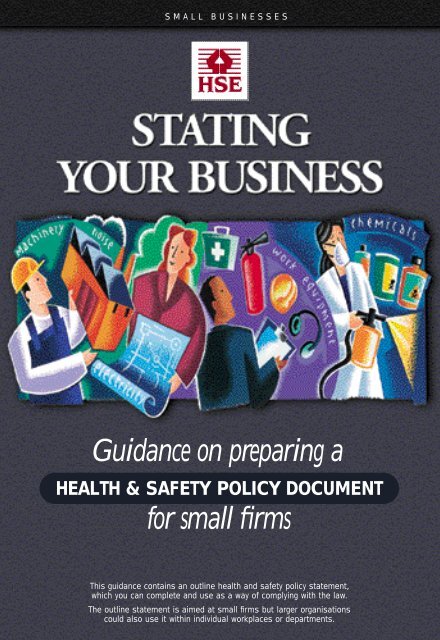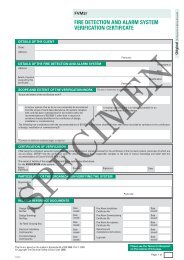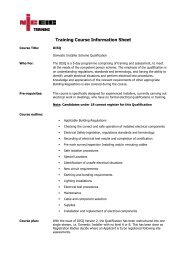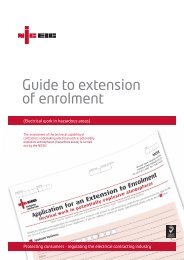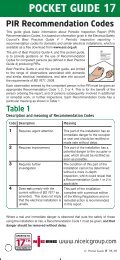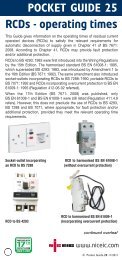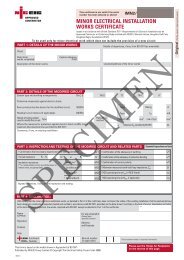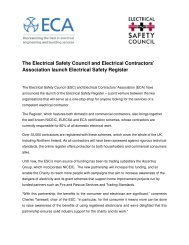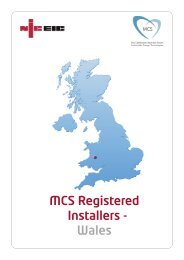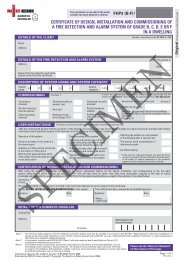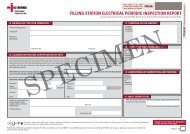Health & Safety Policy - NICEIC
Health & Safety Policy - NICEIC
Health & Safety Policy - NICEIC
Create successful ePaper yourself
Turn your PDF publications into a flip-book with our unique Google optimized e-Paper software.
S M A L LB U S I N E S S E SGuidance on preparing aH E A LT H& SAFETY POLICY D O C U M E N Tfor small firm sThis guidance contains an outline health and safety policy statement,which you can complete and use as a way of complying with the law.The outline statement is aimed at small firms but larger organisationscould also use it within individual workplaces or departments.
2In t ro d u c t i o nWhat is a health and safety policy statement?Your health and safety policy statement setsout how you manage health and safety in youro rganisation. It is a unique document that showswho does what; and when and how they do it.This is an example of a policy statement thatyou can use, fill in and keep in your workplace.H o w e v e r, you do not have to use this documentor format. You are free to re c o rd and store thei n f o rmation in any form you choose. This form a tgives you an idea of the kind of information youneed to re c o rd .Why do I need a health and safety policy statement?The health and safety policy statement is yourstarting point to managing health and safety inthe workplace. By law, (<strong>Health</strong> and <strong>Safety</strong> atWork etc Act 1974 section 2(3)) if you employfive or more people you must have a writtenhealth and safety policy. This contains yourstatement of general policy on health and safetyat work and the organisation and arrangementsfor putting that policy into practice.Writing a health and safety policy statement ism o re than just a legal re q u i rement – it is yourcommitment to planning and managing healthand safety. It is the key to achieving acceptables t a n d a rds, reducing accidents and cases of workrelatedill health and it shows your employeesthat you care for their health and safety.Who should do what?With very few exceptions, the responsibility forhealth and safety rests on you as an employer.However, many day-to-day tasks may bedelegated. Your statement should show clearlyhow these tasks are allocated, but remember,you will still have ultimate responsibility.You should consult your employees (throughsafety representatives, if you have any) aboutthe policy statement. Everyone should be ableto see from the policy statement exactly who isresponsible for different things, such as advice,reporting an accident, and first aid.When and how should they do it?Your policy statement should describe yourarrangements, ie the systems and proceduresyou have in place for ensuring employees’health and safety.You may wish to refer to other documents,eg works’ rules, safety checklists, trainingprogrammes, emergency instructions, etc.All employees may not need to see all theother documents, but they must see the policystatement itself.How often do I need to revise the policy statement?It should be reviewed and possibly revised in thelight of experience, or because of operational oro rganisational changes. It is useful to review thepolicy regularly (eg annually).Do I have to do anything else?Yes, you have other legal duties under otherlegislation. In particular, under the Managementof <strong>Health</strong> and <strong>Safety</strong> at Work Regulations 1999,you have to assess the risks arising from yourwork activities and record the significant findings(you can cro s s - refer to page 5 of this document).You also have to record your arrangements forhealth and safety (you can use this document todo that). Depending on your type of work, theremay be other specific legislation that will apply.REMEMBER: What you write in the policyhas to be put into practice. The true testof a health and safety policy is the actualconditions in the workplace, not how wellthe statement is written.How to use this guidanceThis guidance is split into three parts. It containsa statement of general policy based on your legalduties under the <strong>Health</strong> and <strong>Safety</strong> at Work etcAct 1974. Then you can re c o rd your org a n i s a t i o n a lresponsibilities and your arrangements to ensurethe health and safety of your employees. Notesa re included alongside each section to help you.Some useful publications are listed in the notesand at the end of this guidance.
3<strong>Health</strong> and <strong>Safety</strong> <strong>Policy</strong> St a t e m e n t<strong>Health</strong> and <strong>Safety</strong> at Work etc Act 1974This is the <strong>Health</strong> and <strong>Safety</strong> <strong>Policy</strong> Statement of(name of company)Our statement of general policy is:●●●●●●●●●to provide adequate control of the health and safetyrisks arising from our work activities;to consult with our employees on matters affectingtheir health and safety;to provide and maintain safe plant and equipment;to ensure safe handling and use of substances;to provide information, instruction and supervisionfor employees;to ensure all employees are competent to do theirtasks, and to give them adequate training;to prevent accidents and cases of work-related illhealth;to maintain safe and healthy working conditions; andto review and revise this policy as necessary atregular intervals.Signed(Employer)DateReview date
4R E S P O N S I B I L I T I E SNote 1Your name must be insert e dh e re. As the employer (ie solet r a d e r, senior partner ormanaging director) you haveoverall responsibility for healthand safety.Note 2If you are not always there, ordo not have time to manage ona day-to-day basis, you candelegate this role to someoneelse, eg dire c t o r, manager ors u p e rv i s o . rYou will need toe n s u re that they keep you fullyi n f o rmed of health and safetymatters – it will still be youroverall re s p o n s i b i l i t . yNote 3You may delegate functions topeople within your org a n i s a t i o n ,either by specific areas withinthe workplace or by topic.You should include their specificresponsibilities in their jobdescription (if they have one).You must also ensure that theya re competent to undert a k etheir health and safetyresponsibilities and haveadequate re s o u rces to enablethem to do their job pro p e r l y.It is important thatresponsibilities are clearly setout – this will make sure that ift h e re are any health and safetyc o n c e rns, they can be re p o rt e dto the right person, so they canbe dealt with.You may wish to insert adiagram or chart showing yourmanagement stru c t u re /a rr a n g e m e n t s .Note 4Employees have legalresponsibilities to take care ofthe health and safety ofthemselves and others, and toco-operate with you to help youcomply with the law.E q u a l l y, if employees have anyc o n c e rns over health andsafety issues, they should beclear about whom they shouldtell, so that the concerns canbe addre s s e d .1234Overall and final responsibility for health and safetyis that ofDay-to-day responsibility for ensuring this policy isput into practice is delegated toTo ensure health and safety standards are maintained/i m p roved, the following people have responsibility inthe following are a sNameRe s p o n s i b i l i t i e sResponsibilityAll employees have to:● co-operate with supervisors and managers onhealth and safety matters;● not interfere with anything provided to safeguardtheir health and safety;● take reasonable care of their own health andsafety; and● report all health and safety concerns to an appropriateperson (as detailed in this policy statement).
A R R A N G E M E N T S 5<strong>Health</strong> and safety risks arising fro mour work activities●●●●●●Risk assessments will be undertaken byThe findings of the risk assessments will bereported toAction required to remove/control risks will beapproved bywill be responsible for ensuring the action requiredis implemented.will check that the implemented actions haveremoved/reduced the risks.Assessments will be reviewed everyN o t eYou must assess risks to thehealth and safety of anyonewho may be affected by yourwork activities, so that you canweigh up whether you havedone enough or need to dom o re to comply with the law –see Management of <strong>Health</strong>and <strong>Safety</strong> at Work Regulations1 9 9 9.You will find some examplesof key areas that you shouldc o n s i d e , rat the end of thisg u i d a n c e .You will need to involve anumber of diff e rent people,including your safety re p re s e n -tatives and employees, to dothe risk assessments.You need to re c o rd the significantfindings of your risk assessme n t sin a separate document.Your policy statement onlyre c o rds your arrangements forensuring the assessments aredone, and are kept up to date.Once you have done your riskassessments, you must takethe necessary action to re m o v eor reduce the risk as far as isreasonably practicable.You can find more guidancein HSE’s free leaflets Five stepsto risk assessment I N D G 1 6 3( rev1) 1998 and A guide torisk assessment re q u i re m e n t s :Common provisions in healthand safety law INDG218 1996.or when the work activity changes, whichever issoonest.
6A R R A N G E M E N T SConsultation with employe e sNoteYou must consult youre m p l o y e e s .If you recognise a trade unionand that trade union hasappointed a safety re p re s e n -tative, you must consult themon matters affecting theemployees they re p resent –see <strong>Safety</strong> Representativesand <strong>Safety</strong> CommitteesRegulations 1997.If you do not have trade unions,you must consult employees,either directly or through anelected re p resentative –see <strong>Health</strong> and <strong>Safety</strong>(Consultation with Employees)Regulations 1996.You may wish to use your workscommittee or another meetingas a forum for consultation.If you have a health and safetycommittee, you could list whatit does, who is on it and howoften it meets.●●Employee representative(s) areConsultation with employees is provided by
A R R A N G E M E N T S 7Safe plant and equipment●●●●will be responsible for identifying all equipment/plantneeding maintenance.will be responsible for ensuring effective maintenancep ro c e d u res are drawn up.will be responsible for ensuring that all identifiedmaintenance is implemented.Any problems found with plant/equipment should bereported toN o t eYou will need to ensure thatall plant and equipment(eg lift trucks, vehicles, gasappliances, machinery guard i n g,ladders, electrical equipment,lifting equipment, air re c e i v e r s ,ventilation plant) that re q u i re smaintenance (eg pre - s h i f tchecks, servicing, thoro u g hexaminations) is identified andthat the maintenance is done.It may be worthwhile using alogbook to re c o rd themaintenance checks.When buying new or secondhandplant and equipment, youmust check it meets healthand safety standards beforebuying it.You can find more guidance inthe P rovision and Use of Wo r kEquipment Regulations 1998,Lifting Operations and LiftingEquipment Regulations 1998and HSE’s Buying newm a c h i n e ry INDG271 1998.●will check that new plant and equipment meetshealth and safety standards before it is purchased.
8A R R A N G E M E N T SNoteYou must assess the risksf rom all substances hazard o u sto health – see C o n t rol ofSubstances Hazardous to<strong>Health</strong> Regulations(COSHH) 2002.These are known as yourCOSHH assessments.You should do assessments onsubstances you use (egadhesives, paints, cleaningagent, solvents) andsubstances generated fro mwork activities (eg dust, fume,v a p o u r ) .Your assessment shouldidentify any health risks. Ift h e re is a risk you should takesteps to remove or control therisk.You can find more guidance inH S E ’s: COSHH: A brief guide tothe Regulations I N D G 1 3 6 ( re v 2 )2003 (fre e ); COSHH essentials:Easy steps to control chemicalsHSG193 1999ISBN 0 7176 2421 8 and theCOSHH ACOP and guidance L 52002 ISBN 0 7176 2534 6.●●●●●Safe handlingand use of substanceswill be responsible for identifying all substanceswhich need a COSHH assessment.will be responsible for undertaking COSHH assessments.will be responsible for ensuring that all actionsidentified in the assessments are implemented.will be responsible for ensuring that all relevantemployees are informed about the COSHH assessments.●will check that new substances can be used safelybefore they are purchased.Assessments will be reviewed everyor when the work activity changes, whichever is soonest.
A R R A N G E M E N T S 9In f o rmation, instruction and superv i s i o n●●●●The <strong>Health</strong> and <strong>Safety</strong> Law poster is displayed at/leaflets are issued by<strong>Health</strong> and safety advice is available fromSupervision of young workers/trainees will bearranged/undertaken/monitored byis responsible for ensuring that our employees workingat locations under the control of other employers, aregiven relevant health and safety inform a t i o n .N o t eThe <strong>Health</strong> and <strong>Safety</strong>I n f o rmation for EmployeesRegulations 1989 re q u i reemployers to display a poster(or to provide leaflets) tellingemployees what they need toknow about health and safety.You are re q u i red to haveaccess to competent advice,either in-house or, if notavailable, external (egemployers’ organisations,trade associations, tradesunions, TECs, consultants).If you have young workersand/or take on trainees orstudents on work experience,you will need to ensure thatthey are properly instru c t e dand supervised.You must also do specific riskassessments for young people– you need to take accountof their inexperience, lackof awareness of risks andimmaturity (see the M a n a g e -ment of <strong>Health</strong> and <strong>Safety</strong> atWork Regulations 1999) .If your employees go to workfor another employer on yourbehalf (eg if you are acontractor) you will need tocheck that they are givenrelevant health and safetyi n f o rmation for that location,by that employer/company.
1 0A R R A N G E M E N T SCompetency for tasks and trainingNoteAll employees must be givenhealth and safety inductiontraining when they start work.This can be combined withother useful information(eg pay, leave, and hours ofwork). It needs to cover basichealth and safety such as fir s taid and fire safety.Employees will need jobsp e c i fic training, whichincludes the health and safetyaspects of the job.You also have to provide healthand safety training for peoplewhen risks change, orp e r i o d i c a l , l yeg if skills do notget used re g u l a r l y.Some jobs will re q u i readditional special training(eg manual handling, driving,slinging techniques, confin e dspace entry and asbestosre m o v a l ) .You may wish to refer to yourcompany training pro g r a m m e .It is important to keep re c o rd sof training (even training youhave provided in-house) toshow that employees havereceived training.You should monitor thetraining re c o rds, so thatre f resher training is givenwhen necessary.●●●●Induction training will be provided for all employees byJob specific training will be provided bySpecific jobs requiring special training are…Training records are kept at/by●Training will be identified, arranged and monitored by
A R R A N G E M E N T S 1 1Accidents, first aid andw o rk - related ill health●●●●●●●<strong>Health</strong> surveillance is required for employees doingthe following jobs<strong>Health</strong> surveillance will be arranged by<strong>Health</strong> surveillance records will be kept by/atThe first aid box(es) is/are kept atThe appointed person(s)/first aider(s) is/areAll accidents and cases of work-related ill health areto be recorded in the accident book. The book iskept by/atis responsible for reporting accidents, diseases anddangerous occurrences to the enforcing authority.N o t eEmployees must receivehealth surveillance for cert a i nwork (eg work with flo u r,lead, chrome, asbestos,noise, isocyanates andsome chemicals.This will identify any healthp roblems early on so thataction can be taken before ane m p l o y e e ’s condition worsens.Your COSHH assessments(see page 8) should identify alla reas and the type of healths u rveillance needed.Your re c o rds should containdetails of the employees, thehealth surveillance pro c e d u re s ,dates and conclusions. Thehealth care professional doingthe surveillance will hold theactual medical re c o rds, asthese are confid e n t i a l .You can find more inform a t i o nin HSE’s <strong>Health</strong> Surveillance atw o r kHSG61 1999; U n d e r-standing health surveillanceat work: An introduction fore m p l o y e r sINDG304 1999 ( f re e )and in a number of free leafle t son specific substances.P roviding immediate first aidcan prevent minor injuriesbecoming major ones.As a minimum you must have afirst aid box and an appointedperson to take charge of fir s taid re q u i rements. You can fin dm o re information in HSE’s fre el e a flets First aid at work – yourquestions answere d I N D G 2 1 41 9 9 7and Basic advice on fir s taid at work INDG347 2002.R e c o rding accidents (evenminor ones) means you cansee whether you have ap roblem in a particular are a .You must re p o rt certain typesof accidents and ill health atwork, using Form 2508 orF o rm 2508A – see theR e p o rting of Injuries, Diseasesand Dangerous Occurre n c e sRegulations (RIDDOR) 1995.
1 2A R R A N G E M E N T SMo n i t o r i n gNoteYou must be able to show thatyou are checking workingconditions and systems ofwork, ie that you aremonitoring health and safety.You can do this both activelyand re a c t i v e l y, ie before andafter something goes wro n g .A C T I V E LY :you or any other appointedperson can carry out inspections,have re p o rts submittedto you by managers, do spotcheck visits, safety re p re s e n -tative inspections, etc.Trade union safety repshave the right to carry outinspections and investigatea c c i d e n t s .R E A C T I V E LY :you can investigate anyaccidents or sicknessabsences that occur.Investigating accidents is auseful way of reviewing yoursafety systems – ask yourselfwhy the accident re a l l yhappened and what you can doto stop it happening again.S i m i l a r l y, if you have a numberof employees absent becauseof similar ailments, this mightmean there is a problem withtheir jobs causing ill health.When you find out what wentw rong – put it right.●●●●To check our working conditions, and ensure oursafe working practices are being followed, we willis responsible for investigating accidents.is responsible for investigating work-related causesof sickness absences.is responsible for acting on investigation findings toprevent a recurrence.
A R R A N G E M E N T S 1 3Emergency pro c e d u res –fire and eva c u a t i o n●●●●is responsible for ensuring the fire risk assessmentis undertaken and implemented.Escape routes are checked by/everyFire extinguishers are maintained and checkedby/everyAlarms are tested by/everyo t eYou must carry out fire riskassessments, in the same wayas you do for health and safetyrisk assessments.Your local fire service can tellyou your obligations.For escape routes, extinguishersand alarms, you should statewho checks, how often andalso where they are based.You need a routine in case offire or any other emerg e n c yevacuation. You should testyour alarms and emerg e n c yevacuation pro c e d u res re g u l a r l . yYou can find more inform a t i o non fire safety in HSE’s F i resafety – an employer’s guide1999 ISBN 0 11 341229 0.●Emergency evacuation will be tested everyN
1 4Some key areas of risk●Asbestos●Stress●●●●●●●●ChemicalsConfined spacesDisplay screenequipment (VDUs)ElectricityExcavationFalling objects/collapsing structuresFire and explosionMachinery (includingguarding)●●●●●●Substances hazardousto health (includingdust, fume, etc)TemperaturesTransport (includingcarrying dangeroussubstances, andpedestrians in theworkplace)VibrationViolence to staf fWork equipment●●●●●Manual handlingNoisePressure systemsRadiationSlips, trips and falls●●●●Work-related upper limbdisordersWorking aloneWorking at heightsWorking environmentThese are just some examples of key areas; this is notan exhaustive list. Look around your workplace to identifyother risk areas. If any risks apply to your work activities,you will need to do risk assessments to check that youhave removed or reduced the risk.You can find more information on risk assessments andthe key areas of risk in HSE’s:●●●●Essentials of health and safety at work;<strong>Health</strong> and safety in small firms: An introduction tohealth and safety;Good <strong>Health</strong> is Good Business: Employers’ guide; andFive steps to risk assessment.See ‘Where can I get more information?’ for details ofthese publications.
1 5W h e re can I get more inform a t i o n ?If you still need advice on specific points, check first inthe guidance re f e rred to in the notes or listed below.HSE priced publicationsEssentials of health and safety at workHSE Books 1994 ISBN 0 7176 0716 X<strong>Health</strong> risk management – A practical guide formanagers in small and medium-sized enterprisesHSG137 HSE Books 1995 ISBN 0 7176 0905 7Management of health and safety at work:Management of <strong>Health</strong> and <strong>Safety</strong> at WorkRegulations 1999 Approved Code of Practice andguidance L21 (Second edition)HSE Books 2000 ISBN 0 7176 2488 9HSE free leafletsAn introduction to health and safety:<strong>Health</strong> and safety in small firmsINDG259(rev1) HSE Books 2003Managing health and safety: five steps to successINDG275 HSE Books 1998Consulting employees on health and safety:A guide to the lawINDG232 HSE Books 1996RIDDOR explained. Reporting of Injuries, Diseasesand Dangerous Occurrences Regulations 1995HSE 31(rev1) HSE Books 1999Also available in priced packs; ISBN 0 7176 2441 2<strong>Health</strong> and safety training. What you need to knowINDG345 HSE Books 2001Also available in priced packs; ISBN 0 7176 2137 5Five steps to risk assessmentINDG163(rev1) HSE Books 1998Also available in priced packs; ISBN 0 7176 1565 0While every eff o rt has been made to ensure the accuracy of the re f e re n c e slisted in this publication, their future availability cannot be guaranteed.
HSE priced and free publicationsa re available by mail order fro mHSE BooksPO Box 1999S u d b u ryS u ffolk CO10 2WA.Tel: 01787 881165Fax: 01787 313995Website: www. h s e b o o k s . c o . u k(HSE priced publications are also availablefrom bookshops and free leaflets can bedownloaded from HSE’s website:www.hse.gov.uk.)For information about health and safetyring HSE’s Infoline Tel: 08701 545500Fax: 02920 859260 e-mail:hseinformationservices@natbrit.com or writeto HSE Information Services, CaerphillyBusiness Park, Caerphilly CF83 3GG.This guidance is issued by the <strong>Health</strong> and<strong>Safety</strong> Executive. Following the guidance isnot compulsory and you are free to take otheraction. But if you do follow the guidance youwill normally be doing enough to comply withthe law. <strong>Health</strong> and safety inspectors seek tos e c u re compliance with the law and may re f e rto this guidance as illustrating good practice.This leaflet is available in priced packs of 5f rom HSE Books, ISBN 0 7176 1799 8. Singlef ree copies are also available from HSE Books.© Crown copyright This publication may befreely reproduced, except for advertising,endorsement or commercial purposes. Firstpublished 5/00. Please acknowledge thesource as HSE.INDG324 9/03 C1000Printed and published by the <strong>Health</strong> and <strong>Safety</strong> Executive


